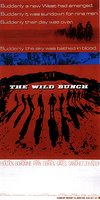 The bloody action in Sam Peckinpah's The Wild Bunch takes place either side of the US/Mexican border--and in one memorable scene, on a bridge directly on the border itself--as a new nation is being born to the South, and an old one is dying to the North.
The bloody action in Sam Peckinpah's The Wild Bunch takes place either side of the US/Mexican border--and in one memorable scene, on a bridge directly on the border itself--as a new nation is being born to the South, and an old one is dying to the North.The film depicts, therefore, a moment of transition. All such transitions are times of violence: the painful uprooting of old traditions and the hard-fought emergence of the new. More violence is around the corner, as the film indicates, with World War One ushering in a global realignment of forces, and the definitive mechanization of death. This is foreshadowed by the use, here, of an automobile as instrument of torture, and a machine gun as agent of unparalleled, indiscriminate mayhem.
At first sight the border between North and South may appear blurred, but only at first sight, or so suggests the Wild Bunch's one Mexican. "Mexico lindo," exclaims the character Angel as the group arrive at the Rio Grande. "Just seems like more Texas as far as I'm concerned," replies one of his partners. "Then you have no eyes," responds Angel.
More...
No comments:
Post a Comment